Matador Network's Blog, page 2134
March 4, 2015
How to piss off a Minnesotan

Photo by Alan Turkus
Disobey the rules of Minnesota Nice.
Minnesota Nice is our cultural identity. It means we have an ingrained aversion to confrontation, we avoid drawing attention to ourselves, and we prefer not to make a fuss. Minnesotans can feign a pleasant demeanor and cheerful attitude even during the most challenging circumstances. Feel like bragging about yourself? In the mood for an argument? Well, keep it under wraps because, gosh darnit — you’re making us uncomfortable.
Play any other way than “Duck, Duck, Gray Duck.”
We know that the rest of humanity plays “Duck, Duck, Goose,” so it’s bewildering that Minnesota seems to be the only state that got the memo that it’s actually “Duck, Duck, Gray Duck.” Collectively, we know our way is better, even if we may never outwardly brag about it. Our way requires more skillful ears. Plus, there’s infinite opportunities for clever trickery–”Duck, duck, duck, grrrr……oss duck! Ahaha, sucka!” Bottom line: Gray ducks are epic, geese are lame.
Fail to adapt to our ways of refusing food three times before accepting.
“Wouldja like some more?”
“No, thank you.”
“Are yah sure?”
“Oh yah, I’m okay fer now.”
“Ders a lot left!”
“I don’t wanna trouble yah.”
“Oh, for Pete’s sake! Have some more!”
“Oh, sure. If you insist!”
Assume Minneapolis and St. Paul are the same.
Though dubbed “The Twin Cities,” these two cities are far from identical. Ask any Minnesotan and they’ll tell you that the 612 and 651 are more like rival siblings than twins. We have a saying here: date Minneapolis, marry St. Paul.
Reference the movie Fargo.
Do we have an accent? You betcha. Is Fargo in Minnesota? No.
Turn down our hotdish.
Um, turn down for what?! What the rest of the world calls casserole, we call hotdish. Tatertot hotdish, wild rice hotdish, tuna noodle hotdish—we love it all. And it doesn’t stop there. Our regional delicacies include bars (cookie baked in a casserole dish), Jell-O salad, sweet potatoes with marshmallows, lutefisk, and our pride and joy: The Juicy Lucy—a hamburger with cheese melted inside the patty.

This story was produced through the travel journalism programs at MatadorU. Learn More
Tell us we sound like Sarah Palin.
Wrong. Sarah Palin sounds like us. No offense to the former vice-presidential nominee, but we wrote the book on folksy lingo. Literally. How to Talk Minnesotan is a book that imparts our regional pronunciation and colloquialisms on how to be indirect, evoke ambiguity, and engineer lengthy conversations around the weather. Apart from looooonng vowels, we also have myriad expressions and words that you won’t find anywhere else, like “Yah, you betcha,” “Dontcha know,” “Oh, for cute!” or “Uff da,” as in, “Uff da! Dis winter sure bin a heckuva cold one, dontchaknow!”
Wear a Green Bay Packers jersey.
If you’re brave enough to claim your allegiance to the Green Bay Packers, say goodbye to Minnesota Nice. The Cold War-esque rivalry between the Packers and Vikings dates back nearly 55 years and the tension has only worsened with time.
Ask “Is that in Wisconsin?”
Reference any affiliation to Wisconsin and prepare to face the burning rage of a thousand suns. There’s nothing worse you can say to a Minnesotan than, “Minnesota and Wisconsin, same thing, right?” No. Just no. Same goes for telling us we’re “basically Canada.”
Forgo the Minnesota Long Goodbye.
The Minnesota Long Goodbye is a staple of our culture. So as not to appear rude, you must linger and drag on polite conversation.
The goodbye begins at the dinner table, as you’re polishing off the last morsels of hotdish left on your plate (you’re full, but you wouldn’t want to be rude! Must. Keep. Eating. Smiling. Agreeing.) You start to pepper in subtle hints to foreshadow your impending departure. Perhaps it’s a quick glance at your watch or a calculated yawn. Your host offers you coffee. You politely decline. You decline again. THREE TIMES YOU DECLINE. You accept the coffee. You sip your coffee while discussing next week’s weather forecast. Another hour passes. Your host offers you leftovers to bring home. You politely decline. You decline again. THREE TIMES YOU DECLINE. You accept the leftovers. You discuss cars and Tupperware. You make your way to the door and begin putting on your layers of polar-vortex garb. You analyze last week’s weather. You casually open the door with a sense of certainty (departure is imminent!). Your host escorts you to your car, during which a conversation on snow tires and deer overpopulation commences. Resting one arm on the frame of your car door and the other holding your now-freezing leftovers, you exchange a few Sven and Ole joke for good measure. Finally, you’re in your car. You roll down the window to continue chatting about next week’s church potluck as you slowly begin to back out of the driveway. Once you’re in the street, waving goodbye from the open window, you’re finally on your way home.
Anything less and you’ve offended your Minnesotan host. Well done. 
18 funniest expressions in Colombia

Photo: Alex
1. Colombians don’t “joke around”…they “give a blowjob to a rooster.” (Están mamando gallo)
2. If Colombians are angry, they don’t merely “leave”…they “open themselves.” (Se abrió)
3. A Colombian doesn’t ask you what you want to do…he asks you, “how is the peanut?” (¿Cómo es el maní?)
4. A Colombian doesn’t “hook up” with someone…instead, they “eat them.” (Ella se lo comió)
5. Colombians don’t “hang out”…they “make a patch.” (Estamos parchando)
6. Colombians don’t say that they’re “friends”…they say that they’re “like fingernails and dirt.” (Son como uña y mugre)
7. A Colombian doesn’t “make a mistake”…they “shit it.” (La cagué)
8. Colombians don’t “put themselves in a position where they will be laughed at”…they just “give papaya.” (Está dando papaya)
9. Colombians don’t “flirt” with each other…they’d much rather “release the hounds” at them! (Él le echó los perros)

This story was produced through the travel journalism programs at MatadorU. Learn More
10. Colombians like to pool money to pay for drinks and meals…when they do, they’re “making a cow.” (Hacemos una vaca)
11. Don’t be alarmed if a Colombian says that they want you to “stop their balls”…they just want you to pay attention to them. (¡Párame bolas!)
12. …but be a little alarmed if their “dwarf grew up”…that’s when you know a problem is getting out of hand. (¡Se nos creció el enano!)
13. Colombians don’t say “be careful”…they say, “put your batteries in.” (¡Ponte las pilas!)
14. A Colombian doesn’t say “how embarrassing”…they say, “what a bear!” (¡Qué oso!)
15. A Colombian doesn’t say, “that person is ugly”…they say, “that person’s uglier than a car seen from below.” (Es más feo que carro visto por debajo)
16. In Colombia, a misbehaving little boy isn’t a “brat”…he’s a “shit from an ass.” (Culicagao)
17. When Colombians are hungry, they’re actually “sharp.” (Tengo filo) If they’re really hungry, they’re so sharp that they could “cut themselves if they bend over!” (¡Tengo un filo que si me agacho me corto!)
18. Soccer is such a big part of Colombian culture, that when they die, they don’t just “die”…they “hang up their soccer shoes.” (Colgar los guayos.) 
10 eating rules French children know (but most Americans don’t)

Photo: Brittany Randolph
HOW THE FRENCH eat, age, dress, raise their children, and live in general is a real talking point these days. So, as an American mother of three half-French kids, I figured I’d add my two cents to the conversation.
I lived in France before becoming a parent, but eventually it was my kids who taught me everything I need to know about eating like a French person: Eating, and staying slim and healthy, isn’t just about what you eat, but also how, when, and why. Yes, French people enjoy junk food occasionally, and sometimes they eat between meals, but people don’t just let loose every day. There’s a code of conduct for food, for big people and little ones alike. Here, in 10 quick life lessons, is what my kids taught me about food.
1. Eat, but not all day long.
Three meals a day, plus the children’s traditional after-school “goûter”, or snack, which might be a pain au chocolat, fruit, or applesauce.
When mealtimes roll around, you eat with real pleasure because you’re hungry.
2. Eat real foods and generous portions.
Because you are consuming three meals a day without grazing in between means, you can eat well when you sit down at the table — and that includes a starter, main course, cheese, and dessert. Portions are generous without going overboard. An example of yesterday’s lunch menu:
Starter course: Lentil salad
Main course: Roasted chicken, green beans
Cheese course: Vanilla yogurt
Dessert: Apple and orange slices
And that was in the public school cafeteria.
3. Choose water.
Generally speaking, the French do not drink their calories. At mealtimes, water (whether still or sparkling) is the drink of choice. Adults might opt for a glass or two of wine, but the glasses aren’t the size of fishbowls.
4. Sit down.
It’s rare to see people eating while walking or shopping. There are no cup holders on caddies, or even in most cars. You eat at the table, not in front of the TV or computer screen, then you leave the table and do something else.
5. Eat lighter at night.
Lunchtime is the main event. Dinner is usually light: soups, salads, an omelet, a simple pasta dish. Dessert might be a yogurt or fruit. And you sleep so much better.
6. When the kitchen closes, it’s CLOSED.
No grazing after dinner.
7. Know your limit, then stop.
Set eating times help you tune in to when you are really hungry or full.
8. Taste your food, guess the ingredients.
The French don’t just like to eat fabulous food and drink wonderful wine, they love to talk about it. Discussing how something tastes, its ingredients, and how it was made increases awareness; children love to join the conversation. They learn about real food and where it comes from.
9. Get cooking!
Along with an interest in ingredients comes an interest in the actual process of cooking food. With a little coaching, my 2-year-old peeled the apples she picked with her class and happily joined in making a tart. Children love helping put fresh vegetables or pasta into the pot, or making a chocolate cake from scratch. Being part of the process heightens appreciation, and builds good habits for life.
10. Eating well is not a sin; it’s a pleasure.
Eating great food — no matter how simple or how elaborate — is one of life’s great pleasures, not an endless guilt trip. Especially when it’s in moderation. Once, when we were visiting family in the US, a waitress asked my French husband if he was “done working on that,” referring to his plate of food. His reply: “Eating is a pleasure, mademoiselle, not work!” 
10 side effects living in Cornwall

Photo: ollie harridge
1. Boozing on the train has become a necessity because getting out of Cornwall takes forever.
Living at the end of the country means that there is an extra four to five hours on every trip and it’s a well-known fact amongst your countymen that both Paris and Brussels are closer to London than you are. Making these ambling trips on public transport has created a tradition of what you like to call The Long Pub, translation: train boozing. When there were harsh rumours being thrown around the British media about alcohol being banned on trains, you were ready to start an uprising — luckily, crisis averted.
2. Summer is now just a blur of hangovers.
When the sun is shining in Cornwall, you crack open a bottle of cider and gather your buddies on the beach for some school-night sundowners. There’s also Boardmasters, Leopallooza, Mazey Day, Flora Day, Porthleven Food Festival, Looe Festival, Harbour Fun Day, the Eden sessions and many, many other excuses to get a little bit silly during the summer months. From May to October, every day is a hangover day.
3. You’ve become a beach snob.
Why go away on a beach holiday to Greece when you can bury your toes in the white sand of Pedn or Porthtowan? Living in Cornwall means that you are spoilt for choice when it comes to where you lay your towel to top up that wonderful, golden Cornish tan and you won’t settle for anything less than perfect.

More like this How to piss off someone from Cornwall
4. You no longer wear shoes.
Whether you’re popping up town to get a pasty or visiting your nan, your chosen footwear is always as close to nothing as you can socially get away with. Going to the shops? Bare feet will do. Work? ‘Flops until you can kick them off under your desk. Wedding? As soon as you’re pissed enough that you don’t care, shoes will be lost forever.
5. You eat and drink sand.
It gets under your nails, sticks to your scalp and gets into every single crack, corner and seam of everything you own. You eat it, you drink it and you never bother getting rid of it because you’ll just be back on the beach tomorrow anyway. You see it as a sign that you’re living the Cornish dream as it is meant to be lived.
6. Everything you own is somewhat pirate-oriented.
Even if this is your first summer in Cornwall, you now own several pirate outfits that will be perfected from yer boots to the feather out o’ yer ‘at. Whether you’ve joined Penzance in getting as many pirates as possible in one place for the Guinness World Record or have got fucked up with a pirate punk band in the local dive bar, you’ve perfected the art of screaming “Y’aaaaaaaaaarrrrr” as loud and as obnoxiously as possible.
7. You’ve started to talk funny.
You’ll see ‘im in an our, ‘e’ll get you that paasty and it’ll taste bleddy ‘ansome.
Yep — “Hs” soon have become a thing of the past and “As” have gotten longer. Basically, you’re sounding like this ‘ere fella and you use the word cock a lot.

More like this 10 signs you learned to drink in Cornwall
8. You’ve learnt to trust the general Cornwall population.
News headlines don’t usually get much more drastic than a seagull stealing the ice-cream out of the hands of an innocent emmet in St Ives or an old dude having a wank in a slurry pit. You don’t lock the door to your house, car or office and you’ve realised that it’s weird to knock on a friend’s door when you’re going for a visit.
9. Your opinion of what bad traffic is has changed drastically.
A legitimate excuse for turning up late to the office is that you got stuck behind a tractor (or three), a herd of cows were crossing the road or a camper van broke down in the middle of the A30. You’ll take that over the M25 any day.
10. You’ve become as tough and rugged as Cornwall’s landscape.
Being surrounded on three sides by the mighty Atlantic Ocean, Cornwall has its fair share of destructive storms. In the winter of 2014, Cornwall was taken into the ring and pummelled to within an inch of its life by bruising waves and whiplashed winds. The heavy swell wiped out not only harbours and sea defences but Cornwall’s travel links in and out of the Duchy. In addition to nature battering us, our hills and cliffs have been mined and hollowed so much they’re caving in under people’s feet. However, none of this really bothers you at all. 
March 3, 2015
8 ways to photograph people
Editor’s Note: MatadorU Photography students showed us some of their favorite candid travel portraits in a recent student lab. To go with the images, MatadorU Photography faculty member Michael Bonocore gives us 8 tips to help improve capturing candid portraits while traveling. 
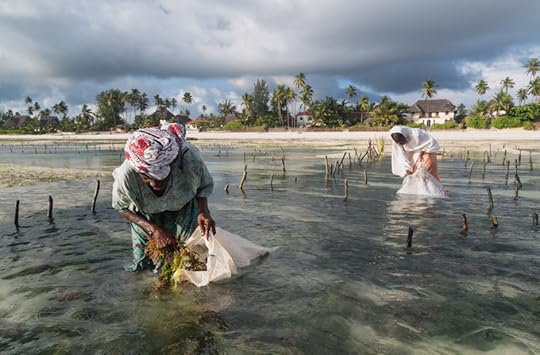
1
Go wide
I knew from the moment I saw this photo from MatadorU student PJ Van Schalkwyk that he had captured this photo at 24mm. There is something about 24mm photos that hold a documentary feel. This is why there is no surprise that most National Geographic photographers frequently use 24mm prime lenses while on assignment. At this wide focal length, you’re able to tell a more compelling story by fitting more of the surrounding scenery into the frame. Also, 24mm prime lenses can be very compact, allowing you to photograph the action without coming off as intrusive.
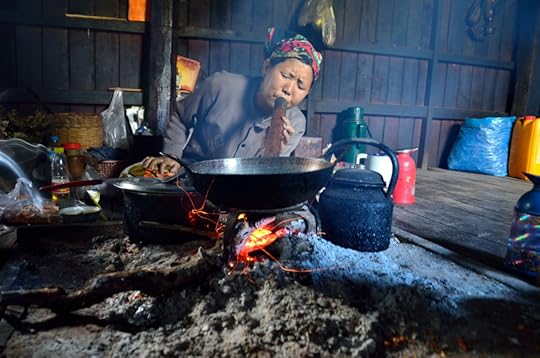
2
Capture Routines
All too often, portraits look very similar. A subject standing in front of the camera, intense eyes gazing into the lens. These portraits are powerful, but when trying to capture a person in a candid manner, what they are doing in that moment is what takes center stage and makes the photograph interesting. When traveling, it is important to tell the stories of the people you encounter, and capturing them simply going about their business can be an impactful and unique look into life in a distant land. It will put the viewer in your shoes, and make them feel like they are right there with the subject. In this photo, MatadorU Student Joanne Chui captured a woman in Kalaw, Myanmar using a bamboo tube to stoke a fire that will be used to prepare dinner.
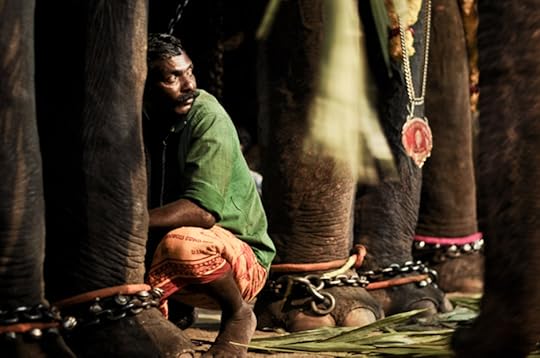
3
Let the background tell the story
Sometimes, it isn’t the actual subject that tells the story, but rather the intimate details that surround them. Imagine if the elephant legs weren’t in this photograph taken in Cochin, India by MatadorU student Brendon Mikronis. There would be nothing to let you know what the man is doing. But the surrounding details fill in the missing elements. Simply having elephant legs in the photo would let you know not only that he works with elephants, but also the chains around the ankles can trigger an emotion in people who are very opinionated about the way that Asian elephants are treated in the tourism industry. Sparking discussion with your photograph is a key indicator that lets you know you told an important story, rather than simply taking a snapshot.
Intermission
186
12 differences between a normal friend and a Spanish friend
by Ana Bulnes
362
What bartenders actually think of your drink order
by Lisa Millar-Jones
12 images that make me proud to call Canada home
by Cassie Kos
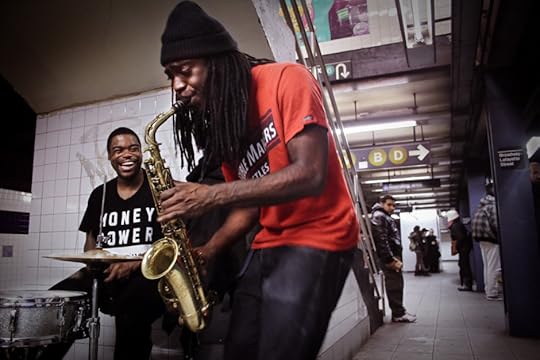
4
Include details that speak to a select group
Small details that invoke an emotional trigger in both residents and frequent travelers can make a photograph seem more real to the viewer. In this photo by MatadorU student Rebecca Plascencia, the New York subway station sign that reads “Broadway-Lafayette Street” immediately makes Manhattan residents stop what they are doing and say “I know that station!” Coupled with the joyful expression on the drummer’s face and the action of the saxophonist, this photo will make New Yorkers proud that they have such a unique and beautiful way to enjoy entertainment. A way that is not common throughout the world.
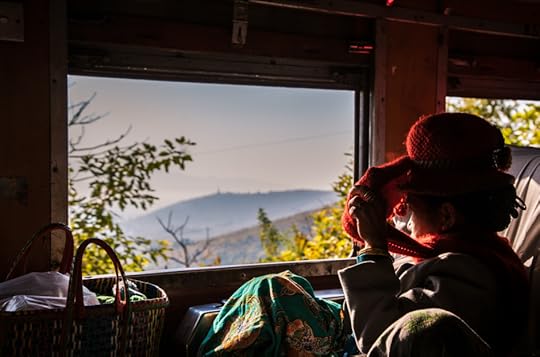
5
Capture reflective moments
Placing the viewer not in the subject’s shoes, but rather their mind, can be powerful story telling element. In this photo from MatadorU student Ben McKechnie, a woman gazes out of the window on a train in the Shan state of northern Myanmar. It is not the scene that draws you in, but rather the question “What is she thinking?” Is she reflecting on her life, stressed about trip she is embarking on, or something deeper? We don’t know, and that is what keeps us staring.
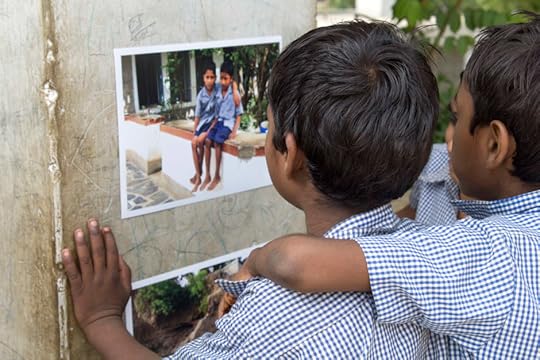
6
Think outside the box
How often do you see photos where the the back of a subject’s head is inches in front of the lens? Not often, but MatadorU student Nicola Young knew that the story unfolding in front of her wasn’t the real life boys in front of her, but rather the printed photograph they were looking at. Every rule in the photography book tells us to not photograph the back of a head just inches away, but sometimes, throwing the rules out the window bring us the strongest images.

7
Confusion is entertainment
In every corner of the globe, scenes unfold that make us scratch our heads, but to the locals in that location, it’s just another day. Take for instance this photograph from Matador U student Brad Mitchell. Every time I look at this photo, I smirk and shake my head. What the hell is going on here? Why is that man just casually holding a bird cage with the intent look of a politician? And more importantly, why is the other man not even noticing, and simply going about his curious gazing? It doesn’t matter why, because it makes an entertaining image.

8
Get to know your subject
This is probably the most important tip of them all. Even though you are taken a candid portrait, there is no reason for you to not approach your subject and talk to them before or after you photograph them. Get to know them, hear their story.
Everyone has a story, and most are happy to tell it, as long as you get to know them a little first. Be courteous and respectful of the location, the person, and their beliefs and traditions. After you take a photo of a subject, always show it to them. Sometimes, you may even have someone ask you to not take their photo or delete a photo you took of them. It is important to respect their wishes.
This photo by MatadorU student James Frazier Garland was possible because of the relationship that James fostered with the subject, an 89-year-old Cuban man by the name of Pedro. While caught in a thunderstorm in Pinar Del Rio, Cuba, Pedro offered James relief from the storm. For an hour, they talked, drank rum and watched the town in front of them go about their business. And James not only has a great travel portrait and story, but also a new friend.
Never say this to hotel workers

Photo: Ade Oshineye
1. “Do you have a banquet room or meeting space our kids can play in?”
So basically, you want us to supervise your children so you can get wasted with the other traveling sports team parents from suburban Wisconsin. We get that you can’t accept you are now a parent and can’t party on Saturday nights, but it’s not our responsibility to entertain your kids and chase them around the hotel while you relive your glory days and get drunk as a midlife-crisis support group. It’s better to be sober, because we will call the police when your unsupervised children jump up-and-down in the elevator and break it. Get ready for $1,000 to be added to your bill.
2. “I stay here all the time.”
For some reason, people feel like if they drop this phrase, they will somehow get a goodie bag or access to the presidential suite, or some other odd reward we’re unaware of. If you have to say this, then it’s likely not the truth. It doesn’t really matter though, because we can look up how often you stay in our hotel — so if this is the third time you’ve been here and you expect red carpet treatment, don’t be disappointed when nobody bows as you walk through the lobby. The guests who really do stay at our property all the time are recognizable because they stay there all the time.
3. “Can your airport shuttle drop us off at the bar?”
Not unless you plan on drinking at the airport bar. The airport shuttle is not your personal party bus; it cannot be used because you have eight drunken friends who don’t want to pay for taxis. I’ve had guests get ridiculously irate over this fact, but I don’t take it personally because they usually get too drunk and forget about it the next day.
4. “What bars are good around here?” — followed by, “What time do you get off work?”
I get it, I’m female and you’re likely away from your wife or girlfriend for the weekend, or on a business trip and someone else is footing the bill. But not only is this a gross violation of hotel policy (we are not allowed to fraternize with guests) and extremely unprofessional (since when do hotel employees moonlight as hookers?), my paycheck does not include flirting with you and “showing you a good time.” Get over yourself.
5. “I didn’t smoke in my hotel room!”
We wouldn’t be asking and risk upsetting a guest unless we had no choice but to put the room out of order, because it needs to be deep-cleaned due to your cigarette stench. Not only are we unable to sell the room to another guest, it’s going to take extra labor to clean it. All you had to do was walk outside and you chose to be lazy, so I don’t feel bad about fining you an extra $250. Just be thankful the smoke alarm didn’t go off and cause a hotel evacuation or call the fire department in — they’re even tougher to deal with.
6. [Checks into hotel, smelling like weed] “So if we put the Do Not Disturb sign on the door, the maids won’t come in, right? And can we pay for our room in cash?”
Alright Willie Nelson, smoke out your car, not our hotel room (and the entire hotel floor). When somebody pays for a room in cash it’s a bit of a red flag anyways because there is no way for us to trace to your money or identity if anything happens (which you are well aware of, hence the sneak tactics). If your first question revolves around making sure we don’t enter your room, you’re basically marking yourself as trouble. If we do suspect you’re carrying out something shady and illegal, keep in mind that our key cards can open any room on the property, and hotel management has the right to enter and search your room without your permission.

More like this 10 really odd things customers have requested from hotel workers
7. “Seriously? You don’t have any rooms? Not even for a rewards member?”
There are various reasons hotel employees tell customers, “I’m sorry, but unfortunately we are sold out tonight.” We might be overbooked, we might have literally sold out, or we might remember the last time you wrecked our property and we just don’t want to service you. But ah, you’re right! I found that room we were hiding from everyone else. Now let me kick another guest out and check you in right away! We understand it’s important to take care of rewards members, but that doesn’t mean we will completely oust someone else and ruin a guest’s experience for your convenience. If a hotel manager knocked on your door and said, “I’m sorry, but because you are not one of our special clients, we are going to have to ask you to leave so we can host one of our preferred members,” how would you feel?
8. “Why do I have to show my government ID to get the government rate?”
To prevent people like you from taking advantage of a courtesy given to government employees. A man once got pissed at me because I wouldn’t honor his government rate when he couldn’t show proof he was a police officer. How many police officers do you know that don’t carry any type of identification with them, even off duty? Our policies are in place for specific reasons, if you aren’t prepared you’ll face a losing battle.
9. “It’s ridiculous that we have to pay for parking.”
This is a hotel. It’s a city and you’re in the middle of the downtown area. Would you be mad if you parked on the street at the meter and had to put coins in? Plus, if you argue you’ve stayed before and didn’t pay for parking, it’s only because parking was already prorated into the rate. So yes, you actually did pay for it.
10. “Can you bring a bucket of ice up to my room?”
We’re providing you with a comfortable place to rest while you’re away from your home. While we are happy to do everything we can to accommodate our guests, it doesn’t mean we don’t judge how lazy you are in the process. THERE’S AN ICE MACHINE ON EVERY FLOOR and if you aren’t capable of getting it yourself, you better pony up with a good tip. 
Essential Burning Man expressions

Photo: Christopher.Michel
1.Burners don’t go to an “art festival” in the middle of the desert… they go home to the playa.
2. Burners don’t just show up or attend… they participate.
3. Burners don’t enter the festival… they (finally, finally) get to the gate.
4. Burners don’t grab a last meal before arriving… they eat Indian tacos while waiting in line.
5. If it’s your first time, it’s never referred to as your “first time”…Instead, you’re a virgin.
6. Burners don’t leave trash around… they collect moop (misplaced objects) and carry it out with them.
7. Burners don’t go to the edge of the world… they go to The Fence.
8. Burners don’t know Valley Girls… they know Playa Princesses.
9. Burners don’t live in houses… they live in camps.
10. Burners don’t have an address… their camp is located at an hour on the grid and a themed street.
11. Burners don’t exchange small talk… they give gifts and hugs to strangers.
12. Burners don’t catch taxis… they hop on Art Cars for a lift.
13. For a Burner, “art” doesn’t go in a museum… Art is what gets torched.
14. Burners don’t run through sprinklers… they run behind the water truck.
15. Burners don’t eat well-balanced meals… they consume free whiskey and bacon.
16. Burners don’t have rich, obnoxious neighbors… they have Turnkey camps.
17. The Burner’s sacred place is not staid or full of noisy decorum… the Temple is silent and full of graffiti.
18. Burners don’t ride in Critical Mass on Friday evening… they ride in Critical Tits.
19. Burners don’t leave the playa when the festival is over… they return to Default. 
How travel made me a strong woman

Photo: Michael Tapp
When I booked it to Vietnam fresh out of college, I’m not sure I was a real person yet. I still wasted the occasional Friday night trying to fit in at sleazy, sweaty clubs drinking far too many UV Blue and lemonades. I still clung onto the shreds of my Catholic guilt. And I still felt ugly and out of place in my body.
But luckily I had Southeast Asia to slap me in the face.
There is a sense of eat or be eaten, sink or swim, when it comes to moving abroad. I grew up in Iowa, where you’re taught that hard work and a smile are really all you need to get by — and in Iowa, I haven’t seen evidence that this isn’t true. In Vietnam, however, you need a backbone — one that defies any and all Western constraints of femininity.
You need cojones.
In America, I was too self-conscious to have cojones. Being aggressive and larger than life, knowing what you want and speaking up for it — these seemed like qualities that would compromise what little femininity I was privy to. I was already nearly six-feet tall, intelligent enough that “statistically” I’m less likely to marry, and never have I once shied away from a firm handshake. I was Geena Davis in a sea of Marilyn Monroes, and I wasn’t okay with it. I was a strong female, but I tried not to be — so really, I was neither.
And then I immersed myself in a culture where the only person who can and will give you a leg up is yourself.
The first time I noticed this was when I went to buy a few bites of watermelon from a fruit vendor. She was patrolling the streets near Bui Vien with her plastic, squeaky, two-wheeled cart. She was leather-skinned, short, stout, very maternal-looking, and felt no shame in looking at me dead in the eye — charging me four times the going amount. I imagined her thinking, “Boy, the pale ones sure do pay off generously.” I know this isn’t a unique story, but it ignited something in me nonetheless.
For awhile, times like that continued, and they gutted my sense of self. I vowed to be acutely aware of never being taken for a ride, got a bit of Vietnamese under my belt, and refused to lower my chin. Between those things, I must have seemed competent and willing to assimilate. Because of this, others — locals — mysteriously allowed me power. I could feel it. I clung onto it as it grew and grew, and with each day I felt more and more in control of my surroundings. Slowly my stares evolved from doe-eyed disbelief to stares of defiance and rebellion. Travel was stoking the fires of a don’t-fuck-with-me vibe, and it would pay off kindly.
The art of bartering is a good place to start for any female who needs to go head-to-head with a culture or head-to-head with herself. It demands that you choose your own stance and stick to it for no reason other than what you’re demanding feels acceptable. It’s the edge of what you’re willing to do, and you will go no further. Really, all of life is just one giant barter — either you cave or they do. By spending my first months avoiding the Big C and buying everything I needed at local markets — mostly Tan Dinh — I learned these lessons and got much, much better at buying fruit. I became more manipulative, too — knowing just when to make someone laugh, being more animated and expressive to open myself up, easing the situation by making myself a spectacle — it all worked in my favor, and, more importantly, it all worked.
As any expat knows, once you become a person somewhere, you’re bits of that person anywhere. Years later, I still see this woman pop out.
These life lessons just don’t happen back home. The aisles of Wal-Mart hardly cater to self-expression and exploration unless you’re trying to return something damaged without a receipt. I was used to putting on a trendy shade of lipstick and a smile to get what I wanted, but this was completely different turf — Southeast Asia demanded that I burn my bra, don my Hillary Clinton power suit, and rock out to a Katy Perry song like I was riding a giant mechanical lion instead of a shitty Honda wave.
Empowerment became addictive for me.
Eventually, this how-dare-you attitude came to life whether I was bartering at Ben Thanh or merely sitting at a stop light on Nguyễn Hữu Cảnh. I drove down the road, guarding my precious sixteen inches of space with an invisible laser shield. I stood dangerously close to the stranger in front of me in every queue, making eyes at potential cutters. I barged out of elevators to make sure I didn’t get sardined inside for another useless jaunt upwards. And I became willing to throw a few elbows and didn’t worry about breaking a nail while doing so.
This newfound sense of self allowed me to stare back at the eyes drilling into me, studying my blonde hair, freckles, and bare legs. I didn’t want to stare at the hairs coming out of their moles, but I’d do it on principle just to prove my point. Driving down the street was a zoo, sure, but elevators were much, much worse. I can’t recall the number of times I heard remarks about my stature only to turn around and join in on the conversation in Vietnamese — putting each gossiper in a state of visible horror.
Losing my sense of shame didn’t always come at the expense of others and it didn’t always involve cultural differences — there were moral ones at times, too. I vividly remember a group of women spilling a few barrels of rice in the middle of a semi-busy street on the outskirts of Saigon. They were sweeping up as many kernels as they could with their woven brooms while angry, harried men careened through their mess. The men paid no mind to the wheels of their motorbikes defeating the women’s work as every spewing kernel was an ode to their victory. As soon as I could, I pulled my bike up perpendicular to the street, angled it next to one of the women’s parked bikes, and blocked all motorists from zooming by. I faced glares, furrowed brows, and a few angry shouts — but, my way, the women were done in minutes and hopefully that week’s livelihood was spared.
And, sure, there were times when my backbone might have gotten the better of me, too. Once a taxi slammed on its brakes at a yellow light and I pancaked myself into its back-end. My bike lay in a pretzel in the middle of a busy road, blood was trickling steadily down my shins, and several of my things decorated the street. The driver came out of his taxi steaming, yelling and attempting to grab my keys, holding them hostage until I coughed up a handsome sum. I held my cool until he started grabbing my arms — to which I responded “Don’t you fucking touch me.” I pointed at my bloody legs, yelled a few expletives, and threw out an uncomfortable amount of eye contact until he finally gave up. I turned to the crowd that had gathered, bowed, picked up the pieces of my bike, and regretted nothing.
Well, sort of. I was proud, but I wasn’t. It was like emerging from a really good, totally necessary one-night stand that you hope you never have to have again.
That being said, there were times when my new attitude saved my ass, too. Being thrown into a foreign environment and actually surviving helps you realize you’re not useless and you’re not weak. There’s a strength in your core that is undeniable, and travel brings that realization to the surface.
When two men drove up beside me to wrestle my wallet from me, I knew I stood a chance. All I needed was a split second’s burst of “Oh, hell no,” and my muscles were in action defending my turf. After a quick tussle, they drove away empty-handed. Without knowing I could handle that situation, I’m not sure I would’ve tried.
As any expat knows, once you become a person somewhere, you’re bits of that person anywhere. Years later, I still see this woman pop out. She gives a stern glance to rude cashiers for just a second too long. She openly yells at people on their cell phones in movie theatres. She wears heels to top her out at a solid 6’1”, and you know what? I like her. She’s a new-age Marilyn Monroe. She’s Emma Stone meets Natalie Portman, she’ll never drink UV blue again, and, thanks to those experiences, the world is her fucking oyster. 
US kids can learn from Argentina

Photo: Ostrosky Photos
1. To be more affectionate with loved ones.
It seems like too many kids in the US only give someone a hug if that person bought them something, or they give the obligatory hug to their aunt / uncle / grandma if their mom or dad push the issue.
Argentine kids know that it doesn’t hurt to give your loved ones lots of hugs. It’s not uncommon for Argentine kids to walk into school and hug the teacher. Even the most ‘too cool for school’ teenager can be heard telling his dad “Te quiero mucho, viejo!” before hanging up the phone.
2. That it’s okay to talk to strangers.
Gringo kids, news flash: Not everyone is out to get you! So take it down a few notches on the paranoid scale, por favor.
Argentines are world-class conversationalists. And they talk to EVERYONE. When kids grow up seeing their parents animatedly chat up every single person they pass, how would a kid not think that it’s okay to talk to strangers? In the end, for me, Argentina feels more like a community where people still help each other out — it’s not even uncommon here in Patagonia to pick up hitchhikers on the side of the road. You can invite the traveler at the bus stop home for dinner. You can offer yerba mate to strangers. Soon enough, they aren’t strangers. Your life is now full of new friends.
3. To allow yourself some free time during the day.
Meaning: You don’t need to wake up, go to school, go to club soccer practice, go to piano lessons, eat some fast food dinner while in the car, get home exhausted, do your homework, go to bed, then wake up and repeat. Para un poco, Yanqui…
If there is one thing that Argentines know how to do, it’s how to kick back and actually enjoy life. Kids here still PLAY. They sit down and eat dinner as a family. They take siestas. They definitely know the value of relaxing.
4. To not be such uptight freaks about germs.
I can’t even count the number of kids at school in the US who ran around with hand sanitizer in their backpacks. Their parents wipe down every possible surface with Clorox wipes. They bathe every single day. And somehow everyone ends up with the flu anyhow.
In Argentina, if you’re thirsty and you see a cup on the table, you take a drink out of it even if it’s not yours. It’s a cup, with liquid. You are thirsty. A huge sense of ownership does not need to complicate things. No one cares if you take a bite of your friend’s sandwich in Argentina. When drinking mate, you share it with every other person in the room, everyone drinking out of the same metal straw. Everyone’s more laid back, share-y…and just all around nice. And, go figure, it seems like people here get sick less.
5. That Christmas does not revolve around you and how many presents you get.
With too many of my friends in the US, if they ask for the latest iPhone or the newest Xbox for Christmas, they fully expect that they will get those things. If not, they feel entitled to throw a fit and get mad at their parents and / or Santa Claus.
In Argentina, especially outside of Buenos Aires, it’s not uncommon for a child to get one, ONE, present at midnight on Christmas Eve. They are usually more than happy, because, honestly, who doesn’t like getting a present? Often, instead of a big to-do with a bunch of stressed-out relatives trying to out-do each other, the family gets together for a day at a lake or river. It’s a relaxed, enjoyable day without all of the money and production involved.
6. That life goes on without fast food.
If you ask someone outside of the US to describe the first thing they think of about people from the US, many unfortunately say loud…and / or overweight. Well, what do you expect from a land of Cheez Whiz and triple hamburgers and mile-high greasy breakfasts from a drive-thru and venti lattes?
Argentine kids sit down at meals. They get together for Sunday asados with the family, where the meat might take 5 hours to slow-grill. School lunchrooms actually have ladies who cook whole food, to be served on real plates with real silverware, and kids are given more than 15 minutes to eat before the bell rings and they have to run back to class.
7. That fun can actually be had without fancy electronics.
In the US, kids often judge how cool you are by what kind of phone you have. They communicate by text, through Facetime, Facebook — anything but actually hanging out. And when they do get together to hang out, they play Xbox or call other friends on the phone. TVs and wifi in their bedroom is somehow considered a necessity.
In Argentina, many phones that kids have don’t even have internet capability. If you get the ancient Nokia with the good flashlight, and 30 pesos worth of credit, that’s still pretty awesome stuff. You can drop that tank from the tallest tree and it won’t break. Kids play board games still, they get the neighborhood kids together to play soccer, etc. I’m not saying that Argentine kids don’t like electronics. Ask any of them if they would like the new iPhone, and yeah, of course they would. But they also know how to live without it.
8. That you don’t need your mommy to go everywhere with you.
In the US, if you want to go with your friends to the bowling alley, you have to have your mom or dad drive you and then they pick you up again. If you want to go to the lake, guess who’s coming with you all day to chaperone? Mommy dearest! The student / parent ratio on field trips is often ridiculous. It’s like kids need to have 20 sets of eyes on them at all times.
But in many places in Argentina, you want to go to a friend’s house? Great. “Here’s some money for the bus or a remise, have fun, see you sometime later today, give hugs and kisses to so-and-so.” Kids can walk alone to the kiosko down the street to buy candy or a juice without their mom assuming a white van with a child molester will pick them up in the half block they have to walk. There’s even things called matinees — dance clubs that open early for kids as young as 10. And by early, I mean they go from 11pm til 2am. Try having that fly in the US.
9. That making plans does not have to be so complicated.
In the US, if you want to sleep over at a friend’s house, it almost definitely would not be on a school night and you would need to plan a week before. Play dates are carefully put on the calendar. Birthday parties are planned a month in advance, with invites and email reminders, and some toy stores even offer ‘registries’ to note down what presents you want.
In Argentina, if you want to go to a friend’s house, go. How do you know if you are going to feel like playing with that kid next Tuesday at 4pm? You’re bored and you feel like hanging out now! Done! And Argentine kids know that all a good birthday party needs is a few kids, a soccer ball, and a massive chocotorta. 
March 2, 2015
Research: We regret not traveling
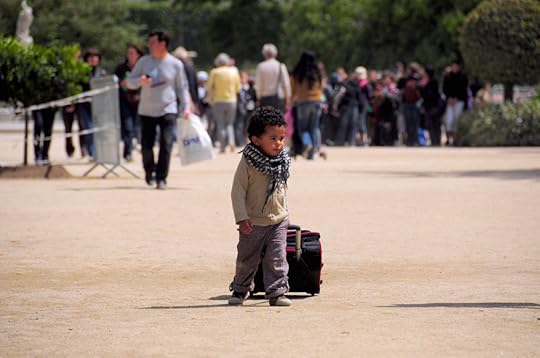
Photo by Faungg’s Photo
THERE ARE ALWAYS REASONS to not travel: a tight budget, a desire to look like a go-getter at work, kids, a busy schedule, nervousness about traveling to “dangerous” countries abroad. If you don’t make travel a priority, you’re probably going to listen to those reasons, and you’re not going to travel all that much.
Chances are, you’re going to regret that. Karl Pillemer is a gerontologist at Cornell, and he has written two books — 30 Lessons for Living and 30 Lessons for Loving — that are based off of advice he compiled from 1000 and 700 elderly people, respectively. Pillemer found that, when he asked the elderly interviewees what their greatest regrets were, not traveling early or often enough was one of the most commonly cited regrets.
One of the most common excuses for not traveling is saying you’ll wait until you retire, or at least until you have more money. But several of Pillemer’s respondents said that this wait was ill-adviced: one 81-year-old man described how he basically lived in the manner of the devastating first ten minutes of the movie Up, and put off traveling until his wife had tragically died of cancer.
Learn from other’s mistakes: get moving
Pillemer’s surveys were largely anecdotal and weren’t necessarily scientific — even though they did cover a pretty large sample size — but his interviews aren’t the only work done in the area. Research by the British Heart Foundation found that the number one regret was not traveling enough. The research also had people create a “to-do” list for what they most wanted in their lives, and the list is dominated by travel-related activities: while first place went to “win the lottery,” second was “travel the world.” Third was to see the northern lights, and going on safaris, seeing world landmarks, and living abroad were all in the top ten as well.
Travel, then, is one of the things we dream about most. But it’s not something we do enough of: Skift found that 41% of Americans didn’t take a single vacation day in 2014, and as a whole, Americans left 169 million paid vacation days on the table. Those are days where there’s no excuse: even if you don’t have the money to take a big trip, why not visit a local state park and go hiking? Why not drive your bike a half an hour away and ride around the countryside?
So many older people — people who we’re in a position to learn from — are telling us to take the time to travel more to avoid having the same regrets that they have. Pillemer summarized the elder’s advice in this way: “Travel is so rewarding that it should take precedence over other things younger people spend money on.”
It’s unaffordable not to travel
Considering that one of the biggest regrets according the British Heart Foundation was “drinking too much,” perhaps one way to save money for travel would be to set aside money that might usually be reserved for bars and put it towards a travel fund. Smoking was also on the regrets list — and smoking is insanely expensive in the United States and in much of the rest of the world these days. If you smoke a pack a week, and a pack of cigarettes costs $7, that’s about $350 a year — the cost of a domestic plane flight.
Saving isn’t spectacularly hard — even on a relatively small income — when you really prioritize it. And there’s evidence that travel is good both for your physical and mental health. The verdict is in: you can’t afford not to travel. And if you don’t, you’ll regret it later. 
Matador Network's Blog
- Matador Network's profile
- 6 followers



